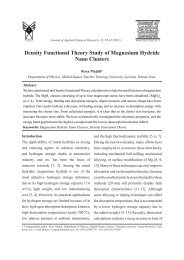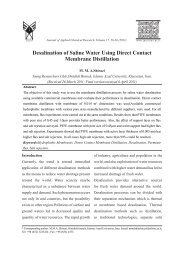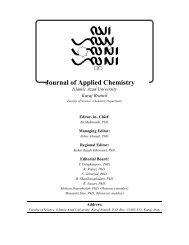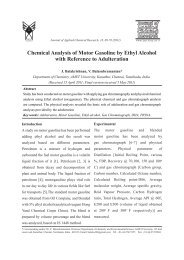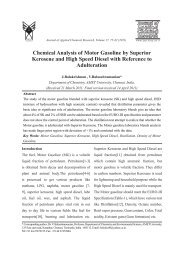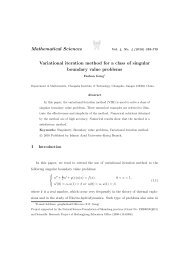Simultaneous Spectrophotometric Determination of Naproxen and ...
Simultaneous Spectrophotometric Determination of Naproxen and ...
Simultaneous Spectrophotometric Determination of Naproxen and ...
You also want an ePaper? Increase the reach of your titles
YUMPU automatically turns print PDFs into web optimized ePapers that Google loves.
Journal <strong>of</strong> Applied Chemical Research, Volume 17, 65-74 (2011)<br />
Journal <strong>of</strong><br />
Applied<br />
Chemical<br />
Research<br />
www.jacr.kiau.ac.ir<br />
<strong>Simultaneous</strong> <strong>Spectrophotometric</strong> <strong>Determination</strong> <strong>of</strong><br />
<strong>Naproxen</strong> <strong>and</strong> Pantoprazole in Pharmaceutical<br />
Dosage Form<br />
S. N.Sloka, B.M. Gurupadayya*, Ch. A. Kumar<br />
Department <strong>of</strong> Pharmaceutical Analysis, JSS College <strong>of</strong> Pharmacy, JSS University, Mysore 570<br />
015, (KA), India.<br />
(Received 25 March 2011; Final version received 15 April 2011)<br />
Abstract<br />
Two simple, but accurate, precise, reproducible, without separation <strong>and</strong> economical procedures for<br />
simultaneous estimation <strong>of</strong> naproxen <strong>and</strong> pantoprazole in combined capsule dosage form have been<br />
developed. One method employs solving <strong>of</strong> simultaneous equations using 262 nm <strong>and</strong> 289 nm as<br />
two analytical wavelengths for both drugs in methanol. The other method is Q- value analysis based<br />
on measurement <strong>of</strong> absorptivity at 262 nm <strong>and</strong> at isoabsorptive point 310 nm showing linearity in<br />
concentration range <strong>of</strong> 10.0- 50.0 μg.ml -1 for naproxen <strong>and</strong> 8.0- 18.0 μg.ml-1 for pantoprazole. The<br />
method was validated with respect to accuracy, precision, limit <strong>of</strong> detection <strong>and</strong> limit <strong>of</strong> quantitation.<br />
The proposed method is recommended for routine analysis since it is rapid, simple, accurate <strong>and</strong> also<br />
sensitive <strong>and</strong> without need to heat <strong>and</strong> organic solvent extraction.<br />
Key words: <strong>Naproxen</strong>, Pantoprazole, Q- analysis, <strong>Simultaneous</strong> equation method.<br />
Introduction<br />
<strong>Naproxen</strong> [(+)-2-(6- methoxy-2 naphtyl)<br />
propionic acid], is a non- steroidal antiinflammatory<br />
drug that also presents analgesic<br />
<strong>and</strong> antipyretic properties. <strong>Naproxen</strong> is<br />
extensively used in the treatment <strong>of</strong> many<br />
diseases e.g. Rheumatoid arthritis, acute gout<br />
<strong>and</strong> primary dysmenorrhea[1].Similar other<br />
non- steroidal, anti- inflammatory drugs, it<br />
inhibits the biosynthesis <strong>of</strong> prostagl<strong>and</strong>ins.<br />
The United States Pharmacopeia [2] reports<br />
high performance liquid chromatography<br />
(HPLC) method for the determination <strong>of</strong><br />
naproxen tablets. Several analytical methods<br />
have also been reported for the determination<br />
<strong>of</strong> naproxen in pharmaceutical preparations<br />
including UV-visible spectrophotomery [3-<br />
5] spectr<strong>of</strong>luorimetry [6-8], phosphorimetry<br />
[9,10], voltammetry [11], high-performance<br />
liquid chromatography [12-14], capillary<br />
* Corresponding author: Dr. .M. Gurupadayya, Pr<strong>of</strong>essor, Department <strong>of</strong> Pharmaceutical Analysis, JSS College <strong>of</strong> Pharmacy, JSS<br />
University, Mysore, S.S. Nagar, Mysore-570 015, Karnatakam India. Email: bm_guru2004@yahoo.co.in Fax:+91 821-2548359,<br />
Cell: +91 9242886136.
66<br />
S. N. Sloka et al., J. Appl. Chem. Res., 17, 65-74 (2011)<br />
electrophoresis [15,16], coulometry[17] <strong>and</strong><br />
oscilometric titration [18].<br />
Pantoprazole sodium 5-(difluromethoxy)-2-<br />
[[3,4- dimethoxy-2- pyridinyl) methyl]<br />
sulfinyl]- 1H- benzimidazolesesquihydate,<br />
proton- pump inhibitor, inhibits gastric acid by<br />
blocking the H + / K + adenosine triphosphatese<br />
enzyme system <strong>of</strong> the gastric parietal cell. It<br />
is used for short- term treatment <strong>of</strong> erosion<br />
<strong>and</strong> ulceration <strong>of</strong> the esophagus. Different<br />
analytical methods are reported in the literature<br />
for the assay <strong>of</strong> pantoprazole sodium in dosage<br />
forms <strong>and</strong> in biological fluids including<br />
spectrophotometry [19-24], TLC [25], <strong>and</strong><br />
HPTLC [26-28]. The present study involves<br />
the simultaneous estimation <strong>of</strong> naproxen <strong>and</strong><br />
pantoprazole in combined dosage form.<br />
Experimental<br />
Instrumentation<br />
UV- Visible spectrophotometer, model UV-<br />
1700 (Shimadzu, Japan) having cells with 1-<br />
cm light path. Shimadzu electronic balance<br />
was used for weighing the samples. <strong>Naproxen</strong><br />
(96.7% purity) was provided by Strides<br />
Arcolab, Bangalore, India <strong>and</strong> Pantoprazole<br />
(98.5%) was suplied from Cresant therapeutics<br />
limited, Hyderabad, India. All other chemicals<br />
<strong>and</strong> solvents used were <strong>of</strong> analytical grade.<br />
Preparation <strong>of</strong> st<strong>and</strong>ard stock solutions<br />
A) St<strong>and</strong>ard NAP stock solution (1mg/ml)<br />
Pure form <strong>of</strong> naproxen powder (50.0mg) was<br />
accurately weighed <strong>and</strong> transferred into 50 ml<br />
volumetric flask <strong>and</strong> dissolved in methanol for<br />
further it diluted by 50 ml methanol (1000μg/<br />
ml). The stock solution is further diluted to get<br />
the required working st<strong>and</strong>ard solutions.<br />
B)St<strong>and</strong>ard PANTO stock solution (1 mg.ml -1 )<br />
Pure form <strong>of</strong> pantoprazole powder (50.0mg)<br />
was accurately weighed <strong>and</strong> transferred to 50 ml<br />
volumetric flask <strong>and</strong> dissolved in methanol. Then<br />
the solution was diluted to 50 ml with methanol<br />
to prepare stock solution (1000 μg.ml -1 ). The<br />
stock solution is then diluted with methanol to<br />
get the stock solution <strong>of</strong> concentration 10μg.ml -<br />
1<br />
. This stock solution is used for preparing the<br />
working st<strong>and</strong>ard solutions.<br />
<strong>Determination</strong> <strong>of</strong> Absorption Maxima<br />
The working st<strong>and</strong>ard stock solutions <strong>of</strong><br />
naproxen <strong>and</strong> pantoprazole were scanned in<br />
the range <strong>of</strong> 200- 400 nm against methanol as<br />
a blank. <strong>Naproxen</strong> <strong>and</strong> pantoprazole showed<br />
absorbance maxima at 262nm <strong>and</strong> 289nm<br />
respectively. The overlain spectra (λ max<br />
) <strong>of</strong> both<br />
drugs was recorded (isoabsorptive point) at<br />
310nm. When compared to other solvents, best<br />
results were found when methanol was used as<br />
solvent <strong>and</strong> very less interference was observed.<br />
Calibration curves (linearity)<br />
A) Calibration curve <strong>of</strong> naproxen<br />
A calibration curve was plotted over a<br />
concentration range <strong>of</strong> 10.0 – 50.0 μg.ml -1 ,<br />
using the stock solution <strong>of</strong> concentration 1000<br />
μg/ml. Accurately measured st<strong>and</strong>ard stock
S. N. Sloka et al., J. Appl. Chem. Res., 17, 65-74 (2011) 67<br />
solution <strong>of</strong> naproxen (0.1, 0.2, 0.3, 0.4 <strong>and</strong><br />
0.5 ml) were transferred to a separate series <strong>of</strong><br />
10.0 ml <strong>of</strong> volumetric flasks <strong>and</strong> diluted to the<br />
mark with methanol. The absorbance <strong>of</strong> each<br />
solution was measured at 262 nm. Calibration<br />
curve was constructed by plotting absorbance<br />
versus concentrations at 262 nm. Each reading<br />
is the average <strong>of</strong> three determinations.<br />
Figure 1.Calibration graph <strong>of</strong> naproxen at λ 1<br />
<strong>and</strong> λ 2<br />
.<br />
B) Calibration curve <strong>of</strong> pantoprazole<br />
curve was plotted over a concentration range<br />
<strong>of</strong> 8.0 – 18.0 μg/ml, using the stock solution <strong>of</strong><br />
concentration 100 μg/ml. Accurately measured<br />
st<strong>and</strong>ard stock solution <strong>of</strong> pantoprazole (0.8,<br />
1.0,1.2, 1.4, 1.6 <strong>and</strong> 1.8 ml) were transferred<br />
to a separate series <strong>of</strong> 10.0ml <strong>of</strong> volumetric<br />
flasks <strong>and</strong> diluted to the mark with methanol.<br />
The absorbance <strong>of</strong> each solution was measured<br />
at 289 nm. Calibration curve was constructed<br />
by plotting absorbance versus concentrations<br />
at 289 nm. Each reading is the average <strong>of</strong> three<br />
determinations.<br />
Method I (<strong>Simultaneous</strong> equation method)<br />
Two wavelengths selected for the method are<br />
262nm <strong>and</strong> 289nm that provide absorption<br />
maximas <strong>of</strong> naproxen <strong>and</strong> pantoprazole<br />
respectively in methanol. The stock solutions<br />
<strong>of</strong> both drugs were measured at the selected<br />
wavelengths <strong>and</strong> absorptivities (a, 1%, 1cm)<br />
for both drugs at both wavelengths were<br />
determined as mean <strong>of</strong> three independent<br />
determinations. Data are represented in Figure<br />
1 <strong>and</strong> 2 respectively.<br />
Figure 2.Calibration graph <strong>of</strong> pantoprazole at λ 1<br />
<strong>and</strong> λ 2<br />
.<br />
Concentrations in the sample were obtained<br />
using following equations:<br />
CX = A 2<br />
ay 1<br />
- A 1<br />
ay 2<br />
/ ax 2<br />
ay 1<br />
- ax 1<br />
ay 2<br />
Eq (i)<br />
CY = A 1<br />
ax 2<br />
- Avax 1<br />
/ ax 2<br />
ay 1<br />
- ax 1<br />
ay 2<br />
Eq (ii)<br />
Where, A 1<br />
<strong>and</strong> A 2<br />
are the absorbances <strong>of</strong><br />
mixture at 262 nm <strong>and</strong> 289 nm respectively,ax 1<br />
<strong>and</strong> ax 2<br />
are absorptivites <strong>of</strong> naproxen at λ 1<br />
<strong>and</strong><br />
λ 2<br />
respectively <strong>and</strong> ay 1<br />
<strong>and</strong> ay 2<br />
are absorptivites<br />
<strong>of</strong> pantoprazole at λ 1<br />
<strong>and</strong> λ 2<br />
respectively.CX<br />
<strong>and</strong> CY are concentrations <strong>of</strong> naproxen <strong>and</strong><br />
pantoprazole respectively.<br />
Method II (Absorption ratio or Q –analysis<br />
method)<br />
From the overlain spectrum <strong>of</strong> naproxen <strong>and</strong><br />
pantoprazole, two wavelengths were selected<br />
one at 310 nm which is the isoabsorptive point<br />
for both drugs <strong>and</strong> the other at 262 nm which is
68<br />
S. N. Sloka et al., J. Appl. Chem. Res., 17, 65-74 (2011)<br />
λ max<br />
<strong>of</strong> naproxen (Figure 3).<br />
The method employs Q - values <strong>and</strong> the<br />
concentrations <strong>of</strong> drugs in sample solution<br />
were determined using the following formula:<br />
For <strong>Naproxen</strong>:<br />
For Pantoprazole:<br />
Figure 3.The curve showing the isobestic point at 310 nm.<br />
The absorbances <strong>of</strong> the sample solutions<br />
prepared in a similar manner as in the previous<br />
method were measured <strong>and</strong> the absorptivity<br />
values for both drugs at the selected<br />
wavelengths were also calculated <strong>and</strong> are<br />
represented in Figures 4 <strong>and</strong> 5 respectively.<br />
Where,<br />
Figure 4. Calibration graph <strong>of</strong> naproxen at λ 1<br />
<strong>and</strong><br />
isobestic point.<br />
Figure 5. Calibration graph <strong>of</strong> pantoprazole at λ 1<br />
<strong>and</strong><br />
isobestic point.<br />
A= Absorbance <strong>of</strong> sample at isoabsorptivity point,a1<br />
<strong>and</strong> a2 = Absorptivites <strong>of</strong> naproxen <strong>and</strong> pantoprazole<br />
respectively at isoabsorptive point.<br />
Application <strong>of</strong> proposed method for the<br />
determination <strong>of</strong> naproxen <strong>and</strong> pantoprazole in<br />
capsules<br />
Ten capsules dosage form (Arthopan)<br />
manufactured by Cresant Therapeutics,<br />
Hyderabad, India were used.Each capsule<br />
contains naproxen 250 mg <strong>and</strong> pantoprazole<br />
50 mg. The contents <strong>of</strong> the capsules were<br />
weighed <strong>and</strong> mixed thoroughly. For analysis<br />
<strong>of</strong> the drug, a st<strong>and</strong>ard addition method was<br />
used. To bring the two drugs in the linearity
S. N. Sloka et al., J. Appl. Chem. Res., 17, 65-74 (2011) 69<br />
range the quantity <strong>of</strong> powder equivalent to 5<br />
mg <strong>of</strong> naproxen <strong>and</strong> 5mg <strong>of</strong> pantoprazole was<br />
weighed <strong>and</strong> dissolved in 30.0 ml <strong>of</strong> methanol<br />
<strong>and</strong> sonicated for 10 min. Then the solution<br />
was filtered through whatman filter paper no.<br />
41 <strong>and</strong> then final volume <strong>of</strong> the solution was<br />
made up to 50.0 ml with methanol to get a stock<br />
solution containing 100 μg/ml <strong>of</strong> naproxen<br />
<strong>and</strong> 100 μg.ml -1 <strong>of</strong> pantoprazole. Appropriate<br />
aliquots <strong>of</strong> naproxen <strong>and</strong> pantoprazole within<br />
the Beer’s law limit were taken. In Method<br />
I, the concentration <strong>of</strong> both naproxen <strong>and</strong><br />
pantoprazole were determined by measuring<br />
the absorbance <strong>of</strong> the sample at 262 nm <strong>and</strong> 289<br />
nm. Values were substituted in the respective<br />
formula to obtain concentrations.Results <strong>of</strong><br />
capsule analysis are shown inTable 1.<br />
Table 1.Analysis <strong>of</strong> Capsule Formulation for naproxen by Method I <strong>and</strong> Method II.<br />
S. No <strong>Naproxen</strong><br />
METHOD I<br />
METHOD II<br />
mg/ capsule % Purity mg/ capsule % Purity<br />
1. 243.09 97.24 245.98 98.39<br />
2. 240.05 96.02 248.09 99.2<br />
3. 232.59 93.03 246.69 98.67<br />
Mean 238.57±0.31193 246.69±0.6199<br />
% RSD 2.26 0.43<br />
RSD = Relative St<strong>and</strong>ard Deviation<br />
For Method II, the concentrations <strong>of</strong> both<br />
naproxen <strong>and</strong> pantoprazole were determined<br />
by measuring absorbance <strong>of</strong> the sample<br />
at 262 nm <strong>and</strong> 310 nm <strong>and</strong> values were<br />
substituted in the respective formula to obtain<br />
concentrations. Results <strong>of</strong> capsule analysis are<br />
shown inTable 2.<br />
Table 2.Analysis <strong>of</strong> Capsule Formulation for pantoprazole by Method I <strong>and</strong> Method II.<br />
S. No Pantoprazole<br />
METHOD I<br />
METHOD II<br />
mg/ capsule % Purity mg/ capsule % Purity<br />
1. 19.09 95.45 18.99 94.95<br />
2. 19.49 97.45 19.01 95.5<br />
3. 19.54 97.7 19.09 95.45<br />
Mean 19.49 19.01<br />
% RSD 1.27±0.1424 0.28± 0.03055<br />
RSD = Relative St<strong>and</strong>ard Deviation.<br />
(Each capsule contains 250.0mg <strong>of</strong> naproxen <strong>and</strong> 20.0mg <strong>of</strong> pantoprazole)
70<br />
S. N. Sloka et al., J. Appl. Chem. Res., 17, 65-74 (2011)<br />
Method validation<br />
Linearity<br />
The linearity <strong>of</strong> an analytical method is its<br />
ability to elicit test results that are directly or<br />
by a well-defined mathematical transformation<br />
proportional to the concentration <strong>of</strong> analyte<br />
in samples within a given range. The range<br />
<strong>of</strong> analytical method is the interval between<br />
upper <strong>and</strong> lower level <strong>of</strong> analyte including<br />
levels that have been demonstrated to be<br />
determined with precision <strong>and</strong> accuracy using<br />
the method. The linear response <strong>of</strong> naproxen<br />
<strong>and</strong> pantoprazole were determined by analysing<br />
three independent levels <strong>of</strong> the calibration<br />
curve in the range <strong>of</strong> 10.0-50.0 μg.ml -1 <strong>and</strong> 8.0<br />
– 18.0 μg/ml -1 respectively for naproxen <strong>and</strong><br />
pantoprazole in triplicate.<br />
(10μg.ml -1 ) for six times <strong>and</strong> analysed as per<br />
the proposed method. Percentage relative<br />
st<strong>and</strong>ard deviation (%RSD).<br />
B)Intermediate precision (Reproducibility)<br />
It expresses within the laboratory variations<br />
as on different days analysis or experiment<br />
within the laboratory. Variation <strong>of</strong> results<br />
within the same day is called intra- day<br />
precision <strong>and</strong> variation <strong>of</strong> results amongst<br />
days called inter- day precision. The intra-day<br />
precision (C.V) was determined for st<strong>and</strong>ard<br />
solutions <strong>of</strong> naproxen (10.0-50.0 μg/ml -1 )<br />
<strong>and</strong> pantoprazole (8.0- 18.0 μg.ml -1 ) for three<br />
times on the same day. The inter-day precision<br />
(C.V) was determined for st<strong>and</strong>ard solutions<br />
<strong>of</strong> naproxen <strong>and</strong> pantoprazole for three days.<br />
Precision<br />
The precision is the measure <strong>of</strong> either the degree<br />
<strong>of</strong> reproducibility or repeatability <strong>of</strong> analytical<br />
method. It provides an indication <strong>of</strong> r<strong>and</strong>om<br />
error. The precision <strong>of</strong> an analytical method<br />
is usually expressed as the st<strong>and</strong>ard deviation,<br />
relative st<strong>and</strong>ard deviation or coefficient <strong>of</strong><br />
variance <strong>of</strong> a series <strong>of</strong> measurements.<br />
A)Repeatability (Precision on replication)<br />
It is a precision under a same condition<br />
(Same analyst, same apparatus, short interval<br />
<strong>of</strong> time <strong>and</strong> identical reagents) using same<br />
sample. Method precision <strong>of</strong> experiment was<br />
performed by preparing the st<strong>and</strong>ard solution<br />
<strong>of</strong> naproxen (10μg/ml -1 ) <strong>and</strong> pantoprazole<br />
Accuracy (% Recovery)<br />
Accuracy <strong>of</strong> an analysis is determined by<br />
systemic error involved. It is defined as closeness<br />
<strong>of</strong> agreement between the actual (true) value<br />
<strong>and</strong> analytical value, obtained by applying test<br />
method for a number <strong>of</strong> times. Accuracy may<br />
<strong>of</strong>ten be expressed as % recovery by the assay<br />
<strong>of</strong> known, added amount <strong>of</strong> analyte (Table 3). It<br />
is the measure <strong>of</strong> the exactness <strong>of</strong> the analytical<br />
method. The recovery experiments were carried<br />
out in triplicate by spiking preciously analysed<br />
samples <strong>of</strong> the capsules (naproxen 10μg.<br />
ml-1<strong>and</strong> pantoprazole 8μg/ml -1 ) with three<br />
different concentrations <strong>of</strong> st<strong>and</strong>ards (naproxen<br />
10, 20,30 μg.ml -1 <strong>and</strong> pantoprazole 8, 10, 12<br />
μg.ml -1 ).
S. N. Sloka et al., J. Appl. Chem. Res., 17, 65-74 (2011) 71<br />
Table 3.Recovery studies.<br />
S. No <strong>Naproxen</strong> Pantoprazole<br />
Amount St<strong>and</strong>ard<br />
Amount <strong>of</strong> % Recovery Amount St<strong>and</strong>ard Amount <strong>of</strong> % Recovery<br />
added<br />
(µg/ml)<br />
Sample Added<br />
(µg/ml)<br />
added (µg/ml) Sample Added<br />
(µg/ml)<br />
1. 10 10 99.43 2 8 101.27<br />
2. 20 10 100.2 4 8 100.57<br />
3. 30 10 98.09 6 8 99.45<br />
Limit <strong>of</strong> Detection<br />
It is the lowest amount <strong>of</strong> analyte in a sample that<br />
can be detected but not necessarily quantified<br />
LOQ = 10 × N/S<br />
Where, N is the st<strong>and</strong>ard deviation <strong>of</strong> the peak<br />
areas <strong>of</strong> the drug <strong>and</strong> S is the slope <strong>of</strong> the<br />
under the stated experimental conditions. corresponding calibration curve.<br />
Limits <strong>of</strong> detection can be calculated using<br />
following equation as per ICH guidelines.<br />
LOD = 3.3 × N/S<br />
Where, N is the st<strong>and</strong>ard deviation <strong>of</strong> the peak<br />
areas <strong>of</strong> the drug <strong>and</strong> S is the slope <strong>of</strong> the<br />
corresponding calibration curve.<br />
Results <strong>and</strong> Discussion<br />
The overlain spectra <strong>of</strong> naproxen <strong>and</strong><br />
pantoprazole exhibit λ max<br />
at 262 nm <strong>and</strong> 289<br />
nm repectively which are quite separated from<br />
each other. The optical characteristics are<br />
given in Table 4.<br />
Limit <strong>of</strong> Quantification<br />
It is the lowest concentration <strong>of</strong> analyte in<br />
Additionally one isoabsorptive point was<br />
observed at 310 nm. This wavelength was<br />
a sample that can be determined with the selected for simultaneous estimation <strong>of</strong><br />
acceptable precision <strong>and</strong> accuracy under<br />
stated experimental conditions. Limit <strong>of</strong><br />
naproxen <strong>and</strong> pantoprazole for Q- value<br />
anlaysis <strong>and</strong> it is assumed to be sensitive to<br />
quantification can be calculated using wavelength. The optical characteristics are<br />
following equation as per ICH guidelines. given in Table 5.<br />
Table 4.Linear regression analysis data with their respective values for Method I.<br />
Method I<br />
Parameter<br />
<strong>Naproxen</strong><br />
Pantoprazole<br />
262 nm 289 nm 262 nm 289 nm<br />
Beer’s law limits (µg/ ml) 10.0 -50.0 10.0 -50.0 8.0- 18.0 8.0- 18.0<br />
Molar absorptivity 5.62 x10 3 1.336 x 10 3 9.153 x 10 3 1.567 x 10 3<br />
(L.mol -1 .cm -1 )<br />
Correlation coefficient (R) 0.998 0.998 0.996 0.999<br />
S<strong>and</strong>ell’s sensitivity (µg.cm -2 ) 0.040 0.172 0.041 0.0245
72<br />
S. N. Sloka et al., J. Appl. Chem. Res., 17, 65-74 (2011)<br />
Regression equation (Y) Y = 0.020X + Y= 0.004X + Y = 0.022X+ Y = 0.04 X+ 0.001<br />
Y= bX+a<br />
0.016 0.004<br />
0.004<br />
Slope, b 0.020 0.004 0.022 0.04<br />
Intercept, a 0.016 0.004 0.004 0.001<br />
Relative st<strong>and</strong>ard deviation% 1.88 2.71 2.43 0.77<br />
Limit <strong>of</strong> detection (µg/ ml) 0.70 0.126 0.825 0.247<br />
Limit <strong>of</strong> quantification (µg /ml) 2.1 0.378 2.475 0.741<br />
Y= absorbance, X=concentration in µg/ml -1<br />
Table 5.Linear regression analysis data with their respective values for Method II.<br />
Method II<br />
Parameter<br />
<strong>Naproxen</strong><br />
Pantoprazole<br />
262 nm 310 nm 262 nm 310 nm<br />
Beer’s law limits (µg/ ml) 10.0 -50.0 10.0 -50.0 8.0- 18.0 8.0- 18.0<br />
Molar absorptivity<br />
5.62 x10 3 1.036 x 10 3 9.153 x 10 3 3.450 x 10 3<br />
(L.mol -1 .cm -1 )<br />
Correlation coefficient (R) 0.998 0.999 0.996 0.999<br />
S<strong>and</strong>ell’s sensitivity (µg.cm -2 ) 0.040 0.22 0.041 0.11<br />
Regression equation (Y)<br />
Y= bX+a<br />
Y = 0.020 X +<br />
0.016<br />
Y = 0.009 X -<br />
0.000<br />
Y = 0.022 X +<br />
0.004<br />
Y = 0.004 X +<br />
0.002<br />
Slope, b 0.020 0.009 0.022 0.004<br />
Intercept, a 0.016 0.000 0.004 0.002<br />
Relative st<strong>and</strong>ard deviation% 1.88 1.11 2.43 1.29<br />
Limit <strong>of</strong> detection (µg /ml) 0.70 0.366 0.825 0.470<br />
Limit <strong>of</strong> quantification (µg/ ml) 2.1 1.098 2.475 1.41<br />
Y= absorbance, X=concentration in µg/ml -1<br />
St<strong>and</strong>ard calibration curves for naproxen <strong>and</strong><br />
pantoprazole were linear with correlation<br />
coefficients(r) values 0.996- 0.999 at all<br />
selected wavelengths <strong>and</strong> the values are<br />
average <strong>of</strong> three readings with st<strong>and</strong>ard<br />
deviation in the range <strong>of</strong> 0.0030 – 0.0121.<br />
The calibration curves were repeated three<br />
times in a day <strong>and</strong> the average % RSD was<br />
found to be 1.11- 2.71 % for naproxen <strong>and</strong><br />
2.43- 0.77 % for pantoprazole at all the<br />
selected wavelengths, similarly the method<br />
was repeated for three days <strong>and</strong> the average<br />
% RSD was found to be 1.15% for naproxen<br />
<strong>and</strong> 2.58% for pantoprazole. The accuracy <strong>of</strong><br />
the method was confirmed by recovery studies<br />
from capsule at three different levels <strong>of</strong><br />
st<strong>and</strong>ard additions. Recovery in the range <strong>of</strong><br />
98.0 – 101.27 % justifies the accuracy <strong>of</strong> the<br />
method. The LOD values were found to be 0.7,<br />
0.126, 0.366 <strong>and</strong> 0.83, 0.25, 0.47 for naproxen<br />
<strong>and</strong> pantoprazole respectively at 262 nm, 289<br />
nm <strong>and</strong> 310nm. The LOQ values were found<br />
to be 2.1, 0.378, 1.098 <strong>and</strong> 2.475, 0.741, 1.41<br />
for naproxen <strong>and</strong> pantoprazole respectively at<br />
262 nm, 289 nm <strong>and</strong> 310nm. Based on various<br />
optical <strong>and</strong>validation parameters, method II is
S. N. Sloka et al., J. Appl. Chem. Res., 17, 65-74 (2011) 73<br />
more sensitive <strong>and</strong> reliable method compared<br />
to method I.<br />
Conclusion<br />
All these factors lead to the conclusion that<br />
the proposed method is accurate, precise,<br />
simple, sensitive, <strong>and</strong> rapid <strong>and</strong> can be applied<br />
successfully for the estimation <strong>of</strong> naproxen <strong>and</strong><br />
pantoprazole in pharmaceutical formulation<br />
without any interference.<br />
Acknowledgement<br />
The authors are thankful to Strides Arcolab for<br />
providing samples <strong>of</strong> pure drug <strong>of</strong> naproxen<br />
<strong>and</strong> Cresant therapeutics Ltd for pantoprazole.<br />
The authors are also thankful to Dr.H.G.<br />
Shivakumar, Principal <strong>of</strong> JSS College <strong>of</strong><br />
Pharmacy for his encouragement to carry out<br />
this work.<br />
References<br />
[1] P.A. Todd, S.P. Clissold, Drugs, 40, 91<br />
(1990).<br />
[2] United States Pharmacopeia National<br />
Formulary, USP 26, NF 21, Rockville, p.1273<br />
2003.<br />
[3] G. Kanoute, E. Nivaud, B. Paulet, P.Boucly,<br />
Talanta, 31, 144 (1984).<br />
[4] M. S Mahrous, M. Abdel-Khakel, M.E.<br />
Abdel-Mamid, J. AOAC, 68, 535 (1985).<br />
[5] I.U. Khan, T. Aman, A. Ashraf, A. Kazi,<br />
Anal.Lett.,32, 2035 (1999).<br />
[6]Damiani, M. Bearzotti, M. A. Cabezón,J.<br />
Pharm. Biomed.Anal., 29, 229 (2002).<br />
[7] D. Wu, Yaowu-Fenxi-Zazhi, Analytical<br />
Abstracts, 19, 62 (1999).<br />
[8] H. Tang, K. Wang, Yaowu-Fenxi-Zazhi,<br />
Analytical Abstracts, 10, 358 (1990).<br />
[9] J. A. Aranciba, G. M. Sc<strong>and</strong>ar, Analyst,<br />
126, 917 (2001).<br />
[10] G. Zhu, H. Ju, Anal. Chim.Acta, 506, 177<br />
( 2004).<br />
[11] N. Adhoum, L. Monser, M. Toumi, K.<br />
Boujlel, Anal. Chim. Acta, 495, 69 (2003).<br />
[12] A. Ekpe, J. Tong, L. Rodriguez, J.<br />
Chromatogr. Sci., 39, 81 (2001).<br />
[13] E. Mikami, T. Goto, T. Ohno, H.<br />
Matsumoto, N. Nishida, J. Pharm. Biomed.<br />
Anal., 23, 917 (2000).<br />
[14] D. Moir, N. Beaulieu, N. Curran, E.<br />
Lovering, J. AOAC., 73, 902 (1990).<br />
[15] J. Sadecka, M. Cakrt, A. Hercegova, J.<br />
Polonsky, I. Skacani,J. Pharm. Biomed. Anal.,<br />
25, 881 (2001).<br />
[16] M. Fillet, L. Fotsing, J. Bonnard, J.<br />
Crommen, J. Pharm. Biomed. Anal., 18, 799<br />
(1998).<br />
[17] Z. Cawrych, E. Szyszko, Acta Pol.<br />
Pharm., 36, 569(1979).<br />
[18] T. Pomazanska-Kolodziejska, Acta Pol.<br />
Pharm.,40, 357 (1983).<br />
[19] N. Ozaltin, A.Kocer, J. Pharm. Biomed.<br />
Anal., 16, 337 (1997).<br />
[20] C.S.P. Sastry, P.Y. Naidu, S.S.N. Murty,<br />
Talanta, 44, 1211 (1997).<br />
[21] S.N. Meyyanathan, J.R.A. Raj, B. Suresh,
74<br />
S. N. Sloka et al., J. Appl. Chem. Res., 17, 65-74 (2011)<br />
Indian Drugs,34, 403 (1997).<br />
[22] A.A.M. Moustafa, J.Pharm. Biomed<br />
Anal., 22, 45 (2000).<br />
[23] A.A.M. Wahbi, O. Abdel-Razak, A.A.H.<br />
MahgoubGazy, M.S. Moneeb, J.Pharm.<br />
Biomed. Anal.,30, 1133 (2002).<br />
[24] F. Salama, N.E.I. Abasawy, S. A. Abdel<br />
Razeq, M.F. Ismail, M.M. Fouad, J.Pharm.<br />
Biomed. Anal., 32, 1019 (2003).<br />
[25] Z.A. EI Sherif, A.O. Mohamed, M.G. EI-<br />
Bardeicy, M. F. EI-Tarras, Spectroscopy Lett.,<br />
38, 77 (2005).<br />
[26] B. Renger, J. AOAC. Int., 76, 7 (1993).<br />
[27] A.P. Argekar, S.S. Kunjir, J Planar.<br />
Chrom. Mod.,9, 296 (1996).<br />
[28] K.K P<strong>and</strong>ya, V. D. Mody, M.C. Satia, I.<br />
A. Modi, R.I. Modi, B.K. Chakravarthy, T.<br />
P. G<strong>and</strong>hi, J. Chrom. B. Biomed. App., 693,<br />
199 (1997).



